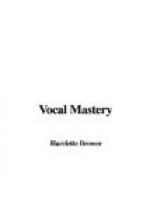“Michael Angelo has said,” continued Mr. Griffith, “that ’a perfect start is our first and greatest assurance of a perfect finish.’ And nowhere is this precept more truly exemplified than in vocal tone production. The tone must have the right beginning, then it will be right all through. A faulty beginning is to blame for most of the vocal faults and sins of singers. Our country is full of beautiful natural voices; through lack of understanding many of them, even when devoting time and money to study, never become more than mediocre, when they might have developed into really glorious voices if they had only had the right kind of treatment.
TONE PLACEMENT
“We hear a great deal about tone placement in these days; the world seems to have gone mad over the idea. But it is an erroneous idea. How futile to attempt to place the tone in any particular spot in the anatomy. You can focus the tone, but you cannot place it. There is but one place for it to come from and no other place. It is either emitted with artistic effect or it is not. If not, then there is stiffness and contraction, and the trouble ought to be remedied at once.
“Every one agrees that if the vocal instrument were something we could see, our task would be comparatively easy. It is because the instrument is hidden that so many false theories about it have sprung up. One teacher advocates a high, active chest; therefore the chest is held high and rigid, while the abdominal muscles are deprived of the strength they should have. Another advises throwing the abdomen forward; still another squares the shoulders and stiffens the neck. These things do not aid in breath control in the least; on the contrary they induce rigidity which is fatal to easy, natural tone emission.
IN THE BEGINNING
“When the pupil comes to me, we at once establish natural, easy conditions of body and an understanding of the causes which produce good tone. We then begin to work on the vowels. They are the backbone of good singing. When they become controlled, they are then preceded by consonants. Take the first vowel, A; it can be preceded by all the consonants of the alphabet one after another, then each vowel in turn can be treated in the same way. We now have syllables; the next step is to use words. Here is where difficulties sometimes arise for the student. The word becomes perfectly easy to sing if vowels and consonants are properly produced. When they are not, words become obstacles. Correct understanding will quickly obviate this.




